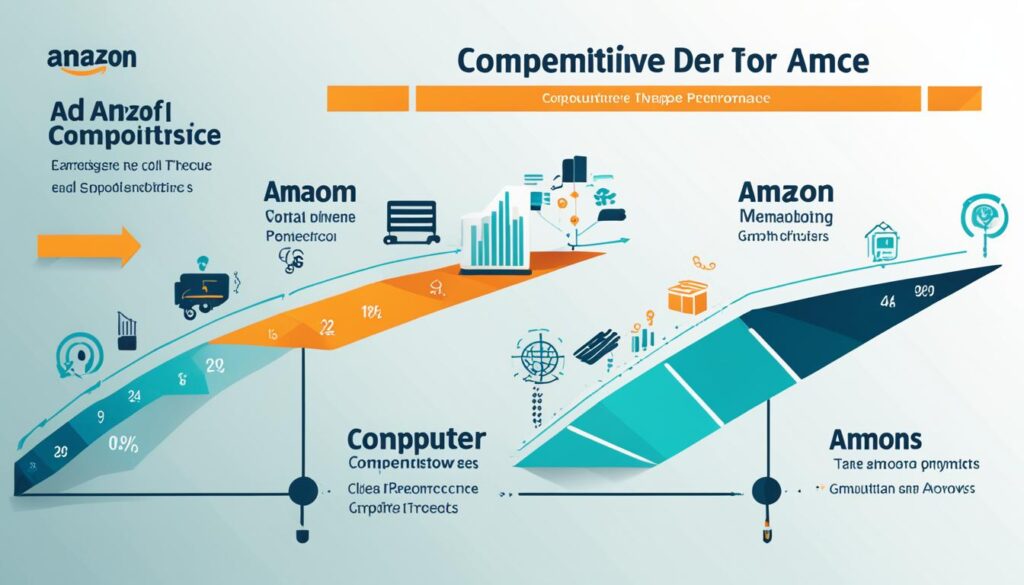Amazon is the biggest online retailer in the world, making it a very competitive business. Sellers who want to succeed on Amazon must continuously be aware of what their competitors are doing and how to improve their own strategies. Ongoing Amazon competitor analysis involves monitoring competitors’ activity, evaluating their pricing tactics, keyword targeting, and other elements that could affect sales and SEO positions. Continuous competitor analysis offers several benefits, such as identifying opportunities for keyword targeting, optimizing product listings, monitoring pricing strategies, staying ahead of trends, and improving customer experience.
Key Takeaways:
- Amazon competition analysis is crucial for identifying opportunities and staying ahead of the competition.
- Continuous monitoring of competitors’ pricing strategies can help sellers maintain competitiveness.
- Analyzing competitors’ product listings can provide valuable insights for optimizing your own listings.
- Understanding market trends through competitor analysis allows sellers to adapt and improve their strategies.
- Analyzing customer reviews and feedback helps sellers identify areas for improvement and enhance the customer experience.
Benefits of Amazon Competitor Analysis for Amazon Sales Growth
Continuous Amazon competitor analysis provides several benefits for Amazon sales growth. When sellers utilize Amazon SEO services and conduct comprehensive competitor research, they gain valuable insights that can enhance their strategy and drive success. Here are some key benefits:
1. Keyword Research and Optimization
Amazon competitor analysis helps identify opportunities for keyword targeting. By analyzing competitors’ product listings and keyword usage, sellers can uncover high-ranking keywords and optimize their own product listings accordingly. This optimization can lead to increased organic traffic, better visibility, and ultimately higher sales.
2. Improved Product Listings
Examining competitors’ product listings allows sellers to identify areas for improvement in their own listings. By analyzing competitors’ product titles, descriptions, and images, sellers can enhance the content and visual presentation of their own listings to be more appealing to customers.
3. Competitive Pricing Strategies
Monitoring competitors’ pricing strategies is crucial for sellers to ensure competitiveness in the market. By analyzing competitors’ pricing history and current prices, sellers can adjust their pricing strategies to maintain competitiveness while maximizing profitability.
4. Stay Ahead of Market Trends
Competitor analysis enables sellers to stay informed about market trends and spot emerging product trends. This insight allows sellers to modify their offerings and align them with current customer demands, enhancing their chances of sales growth.
5. Enhanced Customer Experience
Analyzing competitors’ customer reviews and feedback provides valuable insights into areas for improvement. By understanding customer preferences and pain points, sellers can enhance their own customer experience, earn positive reviews, and drive customer loyalty.
Overall, Amazon competitor analysis is a vital component of a successful Amazon sales growth strategy. By leveraging the benefits of competitor analysis, sellers can optimize their product listings, implement effective pricing strategies, stay ahead of market trends, and create a superior customer experience – all of which contribute to long-term success on the Amazon platform.
| Benefits | Explanation |
|---|---|
| Keyword Research and Optimization | Identify high-ranking keywords to optimize product listings |
| Improved Product Listings | Enhance content and visual presentation to attract customers |
| Competitive Pricing Strategies | Adjust pricing strategies to maintain competitiveness |
| Stay Ahead of Market Trends | Spot emerging product trends and modify offerings |
| Enhanced Customer Experience | Identify areas for improvement based on customer feedback |
How to Run a Competitor Analysis on Amazon?
Conducting a competitor analysis on Amazon is essential for sellers looking to stay ahead of the competition and optimize their strategies. By monitoring competitors’ listings, pricing, inventory, and advertising campaigns, sellers can gain valuable insights and make informed decisions to improve their own operations. Here are the steps to run a comprehensive competitor analysis on Amazon:
Identify Your Main Competitors
Start by identifying your main competitors in your product category or niche. This can be done through various methods, such as using Amazon’s search bar, exploring product categories, and analyzing the “Customers who bought this also bought” section. Take note of the sellers or brands that consistently appear and have a significant presence in your niche.
Utilize Amazon Competitor Analysis Tools
There are several Amazon competitor analysis tools available that can help you gather valuable data about your competitors. Some popular tools include Jungle Scout, AMZ Tracker, and Helium 10. These tools allow you to monitor your competitors’ sales performance, pricing strategies, keyword targeting, and more.
Analyze Competitors’ Listings and Pricing
Monitor your competitors’ product listings to understand how they optimize their titles, descriptions, and images. Analyze their pricing strategies to see how they position themselves in the market and adjust your own pricing accordingly. Take note of any promotions or discounts they offer and evaluate their impact on sales.
Monitor Inventory and Advertising Campaigns
Keep an eye on your competitors’ inventory levels to ensure you have enough stock to meet demand and maintain competitiveness. Additionally, analyze their advertising campaigns to understand their marketing tactics and identify areas for improvement in your own campaigns.
Analyze Customer Reviews and Stay Up-to-Date on Industry Trends
Analyze your competitors’ customer reviews and feedback to gain insights into their strengths and weaknesses. Look for common complaints or praises to inform your own product development and customer service. Stay up-to-date on industry trends and new product launches to identify opportunities for innovation and differentiation.
By following these steps and continuously monitoring your competitors, you can stay competitive on Amazon and enhance your overall performance and sales.
Storefront Checks and Competitor Profiling
Before diving into Amazon competitor analysis, it’s crucial to conduct storefront checks and competitor profiling. These steps provide valuable insights into your competitors’ strategies and help you optimize your own offerings.
Storefront Checks
Storefront checks involve a thorough analysis of your competitors’ product listings, including their titles, descriptions, images, and prices. By examining these elements, you can gain a deeper understanding of how your competitors present and position their products.
“Analyzing competitors’ storefronts allows you to uncover their strengths and weaknesses and identify areas where you can differentiate your brand.”
This analysis can also help you identify gaps in your offerings and make improvements to optimize your product listings.
Competitor Profiling
Competitor profiling goes beyond storefront checks and delves into understanding your competitors’ brand positioning, target audience, and how they engage and communicate with their customers.
By evaluating your competitors’ brand positioning across various channels, such as their website, social media platforms, and marketing campaigns, you can gain insights into their target audience and the messaging that resonates with them.
Understanding how your competitors engage and communicate with their target audience enables you to refine your own marketing strategies and develop effective ways to engage with your customers.
Customer Testimonial:
“Analyzing competitor storefronts and brand positioning has been game-changing for our business. It helped us identify our unique selling propositions and refine our messaging to better engage with our target audience.” – Sarah, Amazon Seller
By conducting storefront checks and competitor profiling, you can gather valuable insights to optimize your product offerings and develop effective marketing strategies that resonate with your target audience. This analysis plays a critical role in staying ahead of your competitors and gaining a competitive edge on Amazon.
| Benefits of Storefront Checks and Competitor Profiling |
|---|
| Identify gaps in your product offerings |
| Optimize your product listings |
| Refine your brand positioning |
| Understand your target audience |
| Develop effective marketing strategies |
Niche Definition and Keyword Research
Clearly defining your niche is essential for successful Amazon competitor analysis. Start by identifying the specific product category and target audience. This helps focus your analysis on direct competitors within your niche, allowing for more precise observations and insights.
Once you have defined your niche, keyword research becomes crucial. Identify key keywords that are relevant to your niche and analyze how your competitors are targeting those keywords. This research enables you to optimize your own product listings and improve your search rankings, aligning your approach with successful competitors’ strategies.
“Proper niche definition and thorough keyword research lay the foundation for effective Amazon competitor analysis. By understanding your niche and analyzing competitors’ keyword targeting, you can optimize your product listings and improve your search rankings.”
By delving into the specific product category and target audience, you can identify areas of opportunity and gain a competitive edge in your niche. Consider the following table, which illustrates the importance of niche definition and keyword research:
| Benefits of Niche Definition and Keyword Research |
|---|
| 1. Improved Search Rankings |
| 2. Targeted Audience Engagement |
| 3. Competitive Advantage in Niche |
| 4. Enhanced Product Offerings |
| 5. Informed Marketing Strategies |
Note: The table above showcases the benefits of niche definition and keyword research for effective Amazon competitor analysis.
Identifying Business Competitors on Amazon
When it comes to Amazon competitor analysis, one of the key steps is identifying your business competitors on the platform. By understanding who your competitors are, you can gain valuable insights into the competitive landscape and find opportunities for differentiation and improvement.
To start identifying your business competitors on Amazon, you can begin by searching for products similar to yours. By searching for relevant keywords or browsing through relevant categories, you can find products that share similarities with your own.
Additionally, analyzing the top-rated lists on Amazon can also help you identify potential competitors. These lists showcase the most popular and well-received products in various categories. Look for brands or sellers that consistently appear in these lists, as they likely have a significant presence in your niche.
Why Analyzing Competitors’ Product Offerings, Pricing Strategies, and Customer Reviews Matters
Analyzing your competitors’ product offerings, pricing strategies, and customer reviews offers valuable insights that can inform your own business strategies. By studying what your competitors are offering, you can gain inspiration for new product ideas or identify gaps in the market that you can fulfill.
Furthermore, analyzing your competitors’ pricing strategies can help you understand how they position themselves in the market. Are they offering premium products at higher prices or are they targeting budget-conscious customers with lower prices? Understanding their pricing strategy can inform your own pricing decisions and help you maintain competitiveness.
Customer reviews are another goldmine of information when it comes to analyzing competitors. By studying the feedback and reviews left by customers, you can gain insights into what customers value and what areas of improvement your competitors may have. This information can help you refine your own products and provide a better customer experience.
Identifying your business competitors on Amazon is an important step in your overall Amazon competitor analysis strategy. By researching similar products, examining top-rated lists, and analyzing your competitors’ product offerings, pricing strategies, and customer reviews, you can gain valuable insights that will inform your own business decisions and help you stand out in the competitive Amazon marketplace.
Analyzing Competitors’ Product Listings
In the world of Amazon, analyzing competitors’ product listings is an essential component of effective Amazon competitor analysis. By understanding how your competitors present their products, you can gain valuable insights to improve your own listings and stay ahead in the marketplace.
When analyzing product listings, start by examining your competitors’ product titles. This is where you can identify relevant keywords and gain inspiration for optimizing your own titles. Take note of the language and tone used in their titles to understand what resonates with customers.
Next, focus on the product descriptions. Analyze how competitors present their products, the level of detail provided, and any unique selling points emphasized. Look for organization techniques and formatting choices that could enhance the readability and effectiveness of your own descriptions.
Remember to pay attention to the product images as well. High-quality and informative images are key to attracting customers and encouraging conversions. Analyze competitors’ images to identify areas for improvement or any missing information that you can include in your own product images.
Analyzing competitors’ product listings allows you to optimize your own listings, better inform customers about your products, and emphasize the benefits that set you apart from the competition. By continuously refining your listings based on competitor analysis, you can enhance your visibility, attract more customers, and drive sales.
Alt text: Amazon competitor analysis – Analyzing Competitors’ Product Listings
Monitoring Competitors’ Pricing Strategies
Monitoring competitors’ pricing strategies is a critical aspect of effective Amazon competitor analysis. By keeping a close eye on the pricing history of your competitors, you can gain valuable insights into their positioning in the market. Understanding how your competitors price their products gives you a competitive edge and allows you to make informed decisions regarding your own pricing strategy.
One useful approach to monitoring competitors’ pricing strategies is utilizing tools like Keepa and Pricepulse. These tools provide valuable insights into pricing fluctuations over time, enabling you to track and analyze the pricing history of your competitors. By observing how their prices change in response to market demand and competitive dynamics, you can make adjustments to maintain your competitiveness.
Adjusting your pricing strategy based on competitor analysis is crucial for staying competitive in the ever-evolving Amazon marketplace. By taking into account pricing information from your competitors, you can make data-driven decisions to set prices that resonate with your target audience and help maintain your competitive edge.
However, it’s important to note that pricing is just one element of a comprehensive competitor analysis. To truly excel in the market, you need to consider a range of factors such as product quality, customer experience, and marketing strategies. By analyzing these aspects alongside pricing, you can uncover new opportunities to differentiate your business and establish a strong position in the marketplace.
This Week’s Best Pricing Strategies
| Competitor | Product | Pricing Strategy |
|---|---|---|
| XYZ Retail | Widget X | Dynamic pricing with limited-time discounts |
| ABC Co. | Widget Y | Everyday low prices with free shipping |
| 123 Inc. | Widget Z | Bundling strategy with high-value add-ons |
In conclusion, monitoring and analyzing competitors’ pricing strategies is a crucial component of Amazon competitor analysis. By leveraging tools and keeping an eye on pricing trends, you can maintain competitiveness and make informed pricing decisions. Remember to consider a holistic approach to competitor analysis, taking into account various factors that contribute to long-term success on Amazon.
Analyzing Competitors’ Sales Performance and Revenue
When it comes to Amazon competitor analysis, examining the sales performance and revenue of your rivals is crucial. This analysis provides valuable insights into the market demand for similar products and the profitability of those products. By understanding the success of your competitors, you can identify opportunities for your own product offerings and adjust your strategies accordingly.
Monitoring competitors’ sales performance allows you to gauge customer preferences and trends within your industry. By analyzing their revenue, you can gain a deeper understanding of the profitability of specific product categories or niches. This knowledge empowers you to make informed decisions about which products to prioritize and invest in.
To illustrate this, let’s consider a hypothetical example:
“Through comprehensive competitor analysis, Seller X identified that their main competitor’s revenue increased by 20% in the past quarter, primarily due to a surge in demand for smart home devices. Armed with this knowledge, Seller X decided to allocate additional resources to develop and launch their own line of smart home devices, capitalizing on the growing market demand.”
This example demonstrates how analyzing competitors’ sales performance and revenue can lead to strategic decisions that drive business growth and profitability.
By using market research tools and techniques, such as Amazon sales data analysis software, you can gather valuable insights and discover the best-selling products in your niche. This information allows you to identify successful products, understand the factors contributing to their success, and tailor your own product offerings accordingly.
Additionally, studying competitors’ sales performance and revenue helps you identify potential gaps or underserved segments in the market. By offering innovative products or addressing unmet consumer needs, you can position your brand as a standout player in the industry.

The image above showcases the importance of analyzing competitors’ sales performance and revenue in determining market trends and identifying successful products.
Amazon Competitors’ Sales Performance
| Competitor | Product Category | Sales Performance (Quarterly Revenue) |
|---|---|---|
| Competitor A | Electronics | $1,500,000 |
| Competitor B | Home & Kitchen | $1,200,000 |
| Competitor C | Fashion | $900,000 |
The table above provides a snapshot of Amazon competitors’ sales performance in different product categories. Analyzing this data helps sellers gain insights into the competitive landscape, identify lucrative segments, and make informed decisions on product development and marketing strategies.
By consistently monitoring the sales performance and revenue of your competitors, you can stay ahead of market trends, optimize your product offerings, and drive revenue growth.
Amazon Competition Analysis Recap
Amazon competitor analysis is an essential strategy for sellers looking to optimize their strategies and gain a competitive advantage on the platform. By analyzing competitors’ product listings, pricing strategies, sales performance, customer feedback, and marketing tactics, sellers can make informed decisions and improve their own operations. The insights gained from competitor analysis enable sellers to identify opportunities for optimization, identify gaps in the market, and stay ahead of the competition.
Continuous improvement and adaptation based on competitor insights are key to long-term success on Amazon. By staying updated on competitors’ actions and strategies, sellers can fine-tune their own approaches and seize opportunities for growth. The optimization of product listings, pricing strategies, and marketing efforts based on competitor insights can lead to increased visibility, higher conversion rates, and ultimately, greater sales and revenue.
In today’s highly competitive e-commerce landscape, gaining a competitive advantage is crucial. Amazon competitor analysis allows sellers to understand their competitors’ strengths and weaknesses, enabling them to differentiate themselves in the marketplace. By leveraging competitor insights, sellers can identify their unique selling propositions, develop compelling value propositions, and effectively communicate with their target audience. This strategic approach not only enhances the customer experience but also positions sellers for long-term success and sustained growth.
Learn More About Amazon Product Research
FAQ
What is Amazon competitor analysis?
Amazon competitor analysis is the process of monitoring and evaluating the activities of competitors on the Amazon marketplace. This includes analyzing competitors’ pricing strategies, keyword targeting, product listings, and customer reviews to identify areas for improvement and gain a competitive advantage.
Why is Amazon competitor analysis important for Amazon sellers?
Continuous Amazon competitor analysis provides several benefits for Amazon sales growth. It helps identify opportunities for keyword targeting, optimize product listings, monitor pricing strategies, stay ahead of trends, and improve the customer experience.
How can I run a competitor analysis on Amazon?
To run a competitor analysis on Amazon, start by identifying your main competitors in your product category or niche. Utilize Amazon’s search bar, product categories, and “Customers who bought this also bought” section to find similar products. Then, use Amazon competitor analysis tools like Jungle Scout, AMZ Tracker, and Helium 10 to monitor your competitors’ sales performance, pricing strategies, and keyword targeting.
What are storefront checks and competitor profiling in Amazon competitor analysis?
Storefront checks involve analyzing competitors’ product listings, including the title, description, images, and prices. Competitor profiling includes evaluating their brand positioning and messaging across various channels. These checks and profiling help sellers understand their target audience, optimize product offerings, and develop effective marketing strategies.
How do I define my niche and conduct keyword research for Amazon competitor analysis?
It’s crucial to define your niche by identifying the specific product category and target audience. This helps narrow down your competitor search and focus the analysis on direct competitors in the niche. Keyword research involves identifying key keywords relevant to the niche and analyzing competitors’ keyword targeting to optimize product listings and improve search rankings.
How can I identify my business competitors on Amazon?
You can search for products similar to yours and analyze the top-rated lists on Amazon. Look for brands or sellers that consistently appear in search results and have a significant presence in your niche. Analyzing competitors’ product offerings, pricing strategies, and customer reviews helps you gain insights into the competitive landscape and identify areas for differentiation and improvement.
What should I analyze in competitors’ product listings during Amazon competitor analysis?
In competitors’ product listings, you should analyze their product titles to identify keywords and inspiration for your own listings. Analyze product descriptions to identify additional product details, organization techniques, and highlighted product benefits you may have missed. Analyzing images helps you identify any areas of improvement or missing information in your own product images.
Why is monitoring competitors’ pricing strategies important in Amazon competitor analysis?
Monitoring competitors’ pricing strategies is crucial to stay competitive on Amazon. By tracking their pricing history and understanding how they position themselves in the market, you can adjust your own pricing strategy to maintain competitiveness and make informed decisions.
How can analyzing competitors’ sales performance and revenue benefit me in Amazon competitor analysis?
Analyzing competitors’ sales performance and revenue provides valuable insights into the market demand for similar products and the profitability of those products. This analysis helps you understand the success of your competitors and identify opportunities for your own product offerings. Monitoring competitors’ sales performance and revenue also helps you gauge customer preferences and launch successful products.
How does Amazon competitor analysis help me gain a competitive advantage?
Amazon competitor analysis helps you optimize your strategies and gain a competitive advantage on the platform. By analyzing competitors’ product listings, pricing strategies, sales performance, customer feedback, and marketing tactics, you can make informed decisions and improve your own operations. Continuous improvement and adaptation based on competitor insights are key to long-term success on Amazon.




